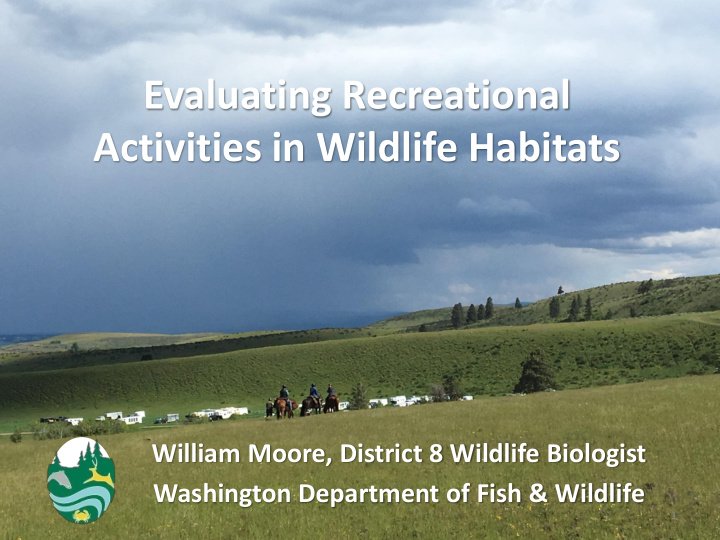



Evaluating Recreational Activities in Wildlife Habitats William Moore, District 8 Wildlife Biologist Washington Department of Fish & Wildlife 1
Presentation Overview • Understand how recreational activities influence wildlife • Review an example recreation model • Discuss modeling possibilities to inform recreation management decisions Gaines, William L.; Singleton, Peter H.; Ross, Roger C. 2003. Assessing the cumulative effects of linear recreation routes on wildlife habitats on the Okanogan and Wenatchee National Forests. Gen. Tech. Rep. PNW-GTR-586. Portland, OR: U.S. Department of Agriculture, Forest Service, Pacific Northwest Research Station. 79 p. 2
Recreation & Wildlife Conservation Goals Stemilt-Squilchuck Vision Plan • Shared Vision and Goals for the Landscape WDFW • Mission Statement 3
Recreation’s Cumulative Effects March-November 2009 , Coleman Canyon 400 300 200 100 0 03-04 03-13 03-22 03-31 04-09 04-18 04-27 05-06 05-15 05-24 06-02 06-11 06-20 06-29 07-08 07-17 07-26 08-04 08-13 08-22 08-31 09-09 09-18 09-27 10-06 10-15 10-24 11-02 11-11 Stemilt-Squilchuck Community Vision Plan 4
Types of Interactions • • • Hunting Movement/Dispersal interference Displacement/Avoidance • • • Poaching Direct and Indirect Fragmentation Stress Hormones • • • Collisions Reduction of Habitat Rearing of young sites • • • Trapping Changes in Edge Effect Reduced Foraging • Change in Pred/Competition Access 5
Consensus of the Available Literature Ski Trail Literature Non-Motorized Trail Literature Roads Literature Motorized Trail Literature 6
Recreational Management Discussions for Wildlife Avoidance/Disturbance • Current management recommendation: – Road/Trail Density Thresholds – Buffer Distances 7
Species Specific Recreational System Reviews using Buffers or Road Density Buffers Road Density Thresholds • • Elk Wolves • • Deer Lynx • • Bighorn sheep Wolverines • • Bears Water shrew • • Mt. Goats Riparian habitat route density • Spotted owls • Northern Goshawks • Brown creepers • Pygmy nuthatch • White-breasted nuthatch • Golden Eagle • Riparian habitat influence • White-headed woodpecker • Three-toed woodpecker • Pileated woodpecker 8
Understanding Buffer Distances 9
Buffer Model Output • Zone of Influence: percentage of a landscape that is affected by human disturbance for a given species (Buffer Area / Defined Area) x 100 = Zone of Influence 10
A Hypothetical Model for the Stemilt Basin 1. Define analysis area 2. Classify the recreation GIS data 3. Determine buffers for each rec activity 4. Account for any other variables 5. Calculate the Zone of Influence 6. Model results for the current condition 7. Model results for recreation alternatives 11
Hypothetical Model: Summer Elk Habitat Summer Elk Habitat Potential Other Habitat Moderate High Highest 12
Stemilt Bulls: Summer Home Range 13
Recreation Type & Appropriate Buffers Recreation ZI Buffer(m) Hiking trails 86 Horseback riding ≈ Mt. biking ≈ Motorized trails 300 Low traffic road 900 >0 to 1/12 hrs Mod traffic road 1000 >2 to ≤ 4/12 hrs High traffic road 1300 >4/12 hrs 14
Forest Security Cover Elk Security Cover: All conifer stands of >70% canopy cover and > 250 acres were excluded from the zone of influence 17
Forest Security Cover 18
Topographic Complexity Line-of-Sight Analysis instead of buffers 19
Topographic Complexity 20
Zone of Influence Scale for Elk Low <30% Moderate 30-50% High >50% 21
Recreation Modeling Possibilities 22
Primary Cavity Excavator Habitat Assessment White-headed & Pileated woodpecker 24
Late-Successional Forest Assessment Northern goshawk Northern spotted owl 25
Riparian Habitat Assessment Winter/non-winter Zone of Influence/Density Index 26
Recreation effect models provide a method to evaluate the cumulative effects recreation has on wildlife The modeling is easily manipulated to investigate current conditions and potential alternatives 27
28
Recommend
More recommend